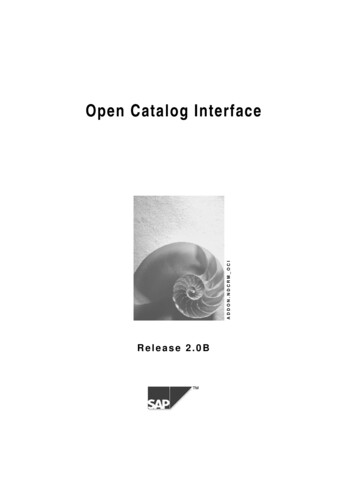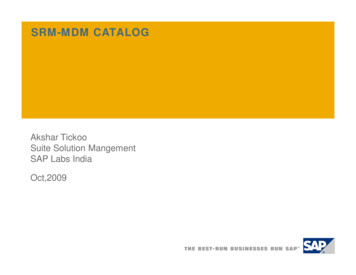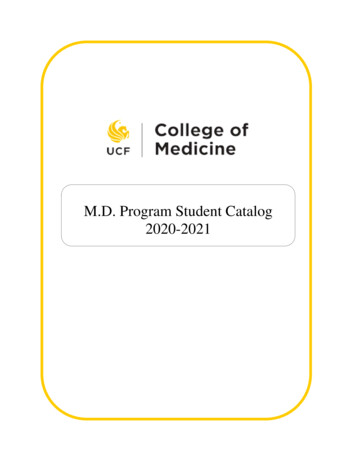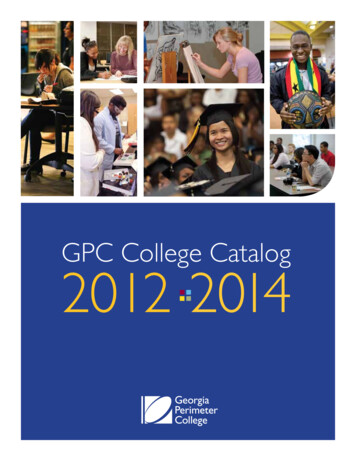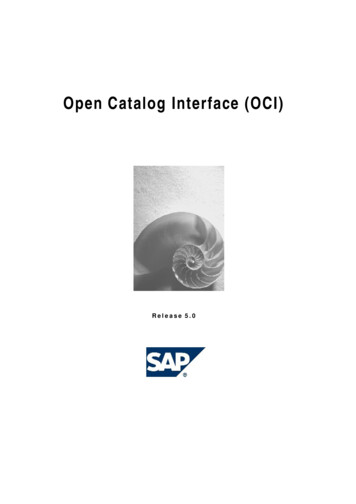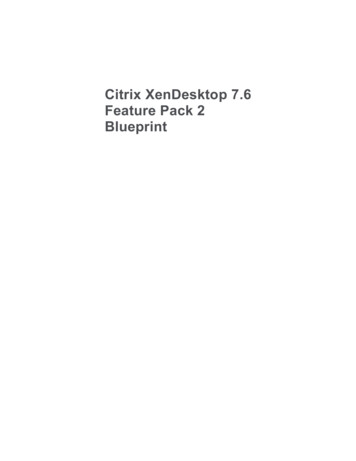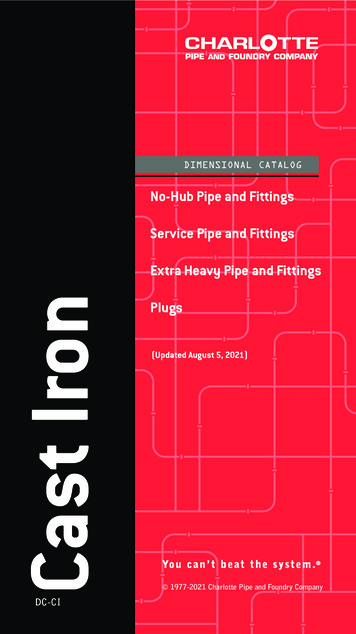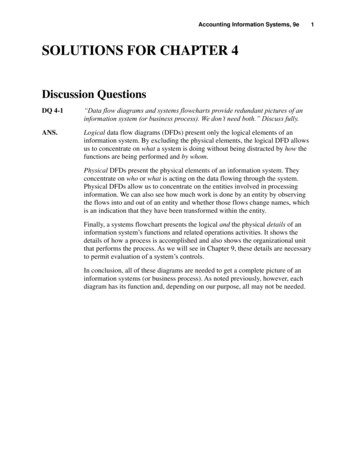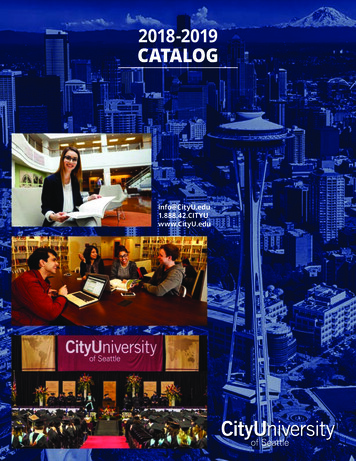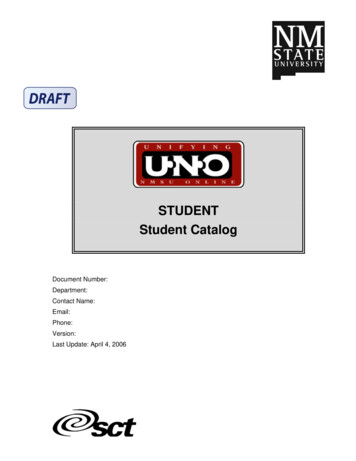
Transcription
STUDENTStudent CatalogDocument Number:Department:Contact Name:Email:Phone:Version:Last Update: April 4, 2006
Student CatalogConfidential Business InformationThis documentation is proprietary information of New Mexico State University (NMSU) and isnot to be copied, reproduced, lent or disposed of, nor used for any purpose other than that forwhich it is specifically provided without the written permission of NMSU.Prepared For: Release 7.xPrepared By:New Mexico State UniversityP.O. Box 30001Las Cruces, New Mexico 88003United States of AmericaIssued: April 2006In preparing and providing this publication, NMSU is not rendering legal, accounting, or othersimilar professional services. NMSU makes no claims that an institution’s use of this publicationor the software for which it is provided will insure compliance with applicable federal or statelaws, rules, or regulations. Each organization should seek legal, accounting and other similarprofessional services from competent providers of the organization’s own choosing. 2006, Regents of New Mexico State University. 1992-1995, 1997, 1999-2002, 2003, Systems & Computer Technology Corporation. All rightsreserved. The unauthorized possession, use, reproduction, distribution, display, or disclosure ofthis material or the information contained herein is prohibited.“SCT,” SunGard SCT, the SCT logo, “Banner” and the Banner logo are trademarks of SunGardSCT. Third-party hardware and software product names and trademarks are owned by theirrespective third-party owners/providers, and SunGard SCT makes no claim to such names ortrademarks.Use of this material is solely for the support of SunGard SCT Banner products and New MexicoState University.For more information about this document, contact training@nmsu.edu.4/4/20062 of 123
Banner User GuideTable of ContentsIntroducing the UNO Project.5Introducing SunGard SCT Banner.7Benefits of SCT Banner.8Introducing the Manual.9Prerequisites.9Objectives of this Manual .9Document Conventions .10Getting Started .11Getting Access to Banner.11Checking the Browser .12Logging into Banner .13Understanding Product Conventions.14Terminology .14Naming Conventions .15Introducing the Banner Interface .16Catalog Procedures .17Entering a New Course into Catalog (SCACRSE) .18Course Change Form Process (CCF) .18New Course: Sub-procedures (SCACRSE) .33Add/Change Specific Details to a Course (SCADETL).33Enter and Maintain Registration Restrictions: Student (SCARRES).44Enter and Maintain Schedule Restrictions: Course (SCASRES).55Maintaining Prerequisite Restrictions at Catalog Level (SCAPREQ) .58Entering a Long Course Title (SCASYLB) .74Entering a Changed Course into Catalog (SCACRSE) .75Course Change Form Process (CCF) .76Cutting a Course in Catalog (SCACRSE) .76Entering the Course Change (SCABASE) .82Changed Course: Sub-procedures (SCACRSE) .83Entering a One-time only Course into Catalog (SCACRSE) .84Course Change Form Process (CCF) .84Entering a One-time Only Course (SCACRSE) .85One-time Only Course: Sub-procedures (SCACRSE) .94Permanently Cutting a Course in Catalog (SCACRSE) .94Course Change Form Process (CCF) .94Permanently Cutting a Course in Catalog (SCACRSE).94Entering the Changed Course (SCACRSE) .100Conducting Non-Term Searches (SCASRCH) .105Producing Catalog Reports (SCRBULT) .108Appendix A: Banner Navigation Aids .115Keyboard Equivalents & Common Banner 7 Buttons.115Banner Buttons.116Appendix B: Student Catalog Glossary .1173 of 1234/4/2006
Student CatalogAppendix C: Banner General Glossary. 119Appendix D: Compatible Browsers. 1234/4/20064 of 123
Banner User GuideIntroducing the UNO ProjectIn June 2003, NMSU pursued an administrative systems software replacement project named“UNO,” or “Unifying NMSU Online.” The goal of the UNO Project is to integrate electronically alladministrative functions of the university. To accomplish this goal, NMSU joined more than1,100 other higher education institutions in choosing SunGard SCT Banner because of itsminimal system modification features.In addition to implementing SCT Banner, NMSU has also implemented other systems to supportSCT Banner, including SCT Luminis, SCT Luminis CMS, Cognos ReportNet, CognosPowerPlay, and SCT Matrix Student Marketing System.Major goals of the UNO Project are to update current processes that use information systems,consolidate core university information into an integrated database, and create new methods ofweb-based self service for university procedures and information.The following systems are described:SystemDescriptionSCT BannerSCT Banner is the suite used for administrative data enterprise wide.SCT LuminisSCT Luminis is the myNMSU portal. The portal is the access point forStudents, Staff, and Faculty to self-service options including: changingpersonal options, entering, time and leave, e-mail, and calendar.SCT Luminis CMSSCT Luminis CMS is a Content Management System designed to helporganize and maintain Web content and facilitate consistency of content,navigation, and look-and-feel of the Universities entire website.Cognos ReportNetCognos ReportNet is the web-based enterprise reporting tool, designedfor you to generate custom reports.Cognos PowerPlayCognos PowerPlay is used to analyze large amount of data.SCT Matrix StudentMarketing SystemSCT Matrix SMS enables NMSU to mange the recruiting and admissionsprocess.5 of 1234/4/2006
Student Catalog4/4/20066 of 123
Banner User GuideIntroducing SunGard SCT BannerSunGard SCT Banner is the new Enterprise Resource Planning (ERP) suite that integrates alldepartments and functions across NMSU onto a single computer system that can serve eachindividual departments need.Internet Native Banner (INB) is the Web version of the new Enterprise Resource Planning suiteNMSU employees will use to access vital university administrative information. One mustaccess INB through a Web browser.The suite acts as an interface between users and an Oracle database containing NMSUadministrative data.The NMSU Banner suite is composed of six systems: Student, Financial, General,Advancement, Financial Aid, and Human Resources. The integrated suite uses rules andvalidation tables to ensure the data are entered and accessed correctly. Since the Bannersystems are highly integrated and share a common Oracle database, everyone who uses thesystems sees common database information in real time.7 of 1234/4/2006
Student CatalogBenefits of SCT BannerSCT has been providing services to the higher education market for over three decades.Developed specifically for higher education institutions, SCT Banner offers the followingbenefits: Available 24 hours a day, 7 days a week access from any authorized web-enabledcomputer. Shared data is entered only once. Individual non-social security ID number for students, faculty, and staff. Electronic signatures, forms and workflow. Oracle database as a basis for generating reports. Ability to implement improved methods to track enrollment. Ability to define clear and consistent data definitions. Strong baseline system to allow NMSU ICT staff to focus on improvements to the system. Integration with NMSU’s web-based course management system, WebCT.4/4/20068 of 123
Banner User GuideIntroducing the ManualThe Banner User Guide: Student Catalog Manual is a stand-alone manual, which covers avariety of business operations processes and accompanying procedures in Banner 7. Not onlydoes the Student Catalog Manual cover how to get started using SCT Banner 7 basics, but alsoit covers how to perform specific daily job tasks, such as: Entering a New Course, Entering aChanged Course, Entering a One-time Only Course, Permanently Cutting a Course, ConductingNon-term Searches and Producing Catalog Reports using Banner 7.PrerequisitesYou should know what your specific business requirements are when you review this manual.This helps you to rapidly understand how the manual’s contents can help you to meet them.You should be able to access and navigate the Banner suite to ensure that you can successfullycomplete any procedures presented in this manual. To learn how to access and navigate theBanner suite, you should either complete the ICT Training Services General Navigation TrainingCourse, or complete the UNO Banner General Navigation Demonstration at:http://www.nmsu.edu/ fsa/files/robodemos/General Navigation.htm.Successful Banner users have experience using Microsoft Windows 2000 version or newer andWindows-compatible Internet browsers or one of the compatible browsers listed in Appendix D:Compatible Browsers.Objectives of this ManualThis manual will introduce you to SCT Banner basics. Once you review this manual you will beable to: Get started Personalize the portal Successfully navigate forms Query forms and information Manage forms and information Locate and use the “Help Menu”9 of 1234/4/2006
Student CatalogAdditionally, after reviewing this manual, you will learn more about Student Catalog-specifictasks and be able to: Enter a New Course into Catalog Enter a Changed Course into Catalog Enter a One-time Only Course into Catalog Permanently Cut a Course in Catalog Conduct Non-term Searches Produce Catalog ReportsDocument ConventionsThese document conventions will point out special information, and help you to successfullyfollow step-by-step instructions in this manual.Notes alert readers of potential problems or to emphasize specialpoints.Tips suggest shortcuts or special hints to make a process easier.Click vs.SelectClick is used for commands, command buttons, option buttons, and choosingoptions in a list, gallery or palette.Examples:On the Tools menu, click Options, and then click the View tab.In the Options dialog box, click the View tab.Select is more passive because it may not trigger an action. Select is used torefer to marking text, cells, checkboxes, option buttons, and similar items thatwill then be subject to a user action.Buttons provide visual examples of Banner navigation aids that you can use toaccomplish specific tasks.4/4/200610 of 123
Banner User GuideGetting StartedIn this section you are given some background information that you will need before you canstart using Banner, including understanding how to access the system and a basicunderstanding of the system design.Getting Access to BannerAccess to Banner is requested on the Web from Financial Systems Administration (FSA). Thefollowing instructions step you through the process for gaining access to Banner. Once youhave completed the following steps to request access to Banner, you will receive an e-mailverifying that access has been granted and notifying you of your password.Instructions1.Open a browser session.2.Type the URL: http:///www.nmsu.edu/ boffice/index1.html.The Business and Finance Web site displays.3.On the Reports/Forms menu, click Forms.4.Scroll to find the Request for Computer Systems Access Form and click the E-formiconto open the form.The Request for Computer Systems Access form contains interactive formfields that allow you to type the information directly on the form.11 of 1234/4/2006
Student Catalog5.Complete the applicable sections for requested systems.6.Read and sign the disclosure agreement7.Submit to the necessary approver for the required approval.8.Forward the original form to Financial Systems Administration, MSC 3FSA, Hadley Hallroom 12, or fax a copy to 646-1994.9.Keep a copy for your files.If assistance is needed to complete the form, please contact 646-HELP(4357).Checking the BrowserYou should use one of the approved browsers to use Banner successfully. Although youprobably could log on to Banner with any browser, there could be a point where certain featuresmight not work.It becomes very obvious that something is wrong when buttons don’t work, or features won’tload. The first step in troubleshooting any Banner problems will be to verify the browser issupported.There may also be additional installs when you first access Banner such as Oracle JInitiator,and/or a Sun plug-in. These additional installs will automatically prompt you the first time youaccess Banner from your machine.A complete list of the browsers supported by Banner and the needed installs are found inAppendix D: Compatible BrowsersIf you have any questions or problems with your browser, please contact ICT Help Desk athelp@nmsu.edu or 646-1840.4/4/200612 of 123
Banner User GuideLogging into BannerBanner supports authenticated user access. To use Banner as an authenticated user, you mustsuccessfully log in by providing your credentials: NMSU Username and Banner Password.Instructions1.Open a browser session.2.Type the URL: http://www.nmsu.edu/erp/.The Logon screen displays.You can create a bookmark in your browser for quick access to Banner.3.Type your NMSU Username and Banner Password.4.Click OK.Your Banner session begins with the following Main Menu.13 of 1234/4/2006
Student CatalogUnderstanding Product ConventionsWhen you first are introduced to a new system, it is like learning a new language. This sectionexposes you to some of the basics of Banner terminology, the system structure and the namingconventions used in Banner and this manual.TerminologyUnderstanding the terms provided in this manual will help you to understand the explanationsand instructions presented in this manual, and to present clear, specific questions that you mayhave about the information provided.This table defines the basic components of the Banner suite.SuiteThe SunGard SCT Banner suite is an administrative software application suitedeveloped specifically for higher education institutions by SunGard Systems andComputer Technology Corporation (SCT). The software acts as an interfacebetween users and an Oracle database containing New Mexico State Universityadministrative data.SystemThe NMSU Banner suite is composed of six systems: General, Student,Advancement, Financial, Human Resources, and Financial Aid.ModulesEach system is composed of specific modules that “break out” components of thesystem.FormsForms are screens that contain fields.FieldsFields are areas in a form that are used either to display specific data (such assomeone’s last name, address, or NMSU ID number), or insert data.Validation Validation tables contain Lists of Values (LOVs) that are pre-defined for a specificfield.TablesBlocksBlocks are groups of related fields within a form.For more terms, see Appendixes B & C: Student Catalog and Banner General Glossaries.4/4/200614 of 123
Banner User GuideThis image shows the structure of SCT Banner Suite components and sample modules, forms,and fields.Naming ConventionsAll Banner forms, reports, jobs, and tables have seven character names which follow thestructure rules outlined below.Using the SOAIDEN form as an example:Name:SOAIDENPosition:1234567Position 1- identifies the product owning the form, report, process or table. In the case of thePerson Identification Form - Student, the first letter S refers to Student.Position 2- identifies the application module owning the form, report, process or table. In thecase of the Person Identification Form - Student example above, the second letter O, refersto Operations.Position 3- identifies the type of form, report, job, or table (in this case, the A in SOAIDENstands for an Application form).Positions 4, 5, 6, and 7- are unique identifiers for the form, report, job, or table (SOAIDEN isthe Person Identification form for NMSU).15 of 1234/4/2006
Student CatalogIntroducing the Banner InterfaceInternet Native Banner (INB) is the Web version of the new ERP system NMSU employees willuse to access vital university administrative information. You must access INB through a Webbrowser.Once you have logged into Banner you will be presented with the Main Menu. This menu is thestarting point for navigating throughout Banner.Menu BarTool BarTitle BarAuto HintStatus Line4/4/200616 of 123
Banner User GuideCatalog ProceduresCatalog procedures begin with entering a new course or changing an existing course using theSCACRSE form. Once the course is entered on the SCACRSE form, other sub-procedures mayalso be completed. This section provides a detailed description of the catalog procedures, andsub-procedures, used to create the master list of courses that comprise the NMSU Catalog: Entering a New Course into Catalog (SCACRSE)oAdd/Change Specific Details to a Course (SCADETL)oEnter and Maintain Registration Restrictions: Student (SCARRES)oEnter and Maintain Registration Restrictions: Course (SCASRES )oMaintaining Prerequisite Restrictions at Catalog level (SCAPREQ)oEntering a Long Course Title (SCASYLB)Entering a Changed Course into Catalog (SCACRSE)oEntering an Effective End-date to a Course (SCABASE)oAdd/Change Specific Details to a Course (SCADETL)oEnter and Maintain Registration Restrictions: Student (SCARRES)oEnter and Maintain Registration Restrictions: Course (SCASRES )oMaintaining Prerequisite Restrictions at Catalog level (SCAPREQ)oEntering a Long Course Title (SCASYLB)Entering a One-time only Course into Catalog (SCACRSE)oEntering an Effective End-date to a Course (SCABASE)oAdd/Change Specific Details to a Course (SCADETL)oEnter and Maintain Registration Restrictions: Student (SCARRES)oEnter and Maintain Registration Restrictions: Course (SCASRES )oMaintaining Pre-requisite Restrictions at Catalog level (SCAPREQ)oEntering a Long Course Title (SCASYLB)Permanently Cutting a Course in Catalog (SCACRSE)oEntering an Effective End-date to a Course (SCABASE) Conducting Non-Term Searches (SCASRCH) Producing Catalog Reports (SCRBULT).The SCABASE form—which allows users to enter an effective end-date to aChanged Course, a One-Time Only Course, or a Permanently Deleted Course—caneither be completed after all tasks are performed using the SCACRSE form, or afterother tasks using sub-procedure forms are completed.17 of 1234/4/2006
Student CatalogEntering a New Course into Catalog (SCACRSE)The Basic Course Information (SCACRSE) form is used to Enter a New Course intoCatalog, using the information found on the Course Change Form (CCF). The informationentered on the SCACRSE form is the minimum information needed to add a course to Catalog.No other Catalog form can be accessed for that course until a course is added to Catalog usingSCACRSE. Any changes made to Catalog are kept as an historical record.Course Change Form Process (CCF)The following process must be followed before a New Course can be entered into the Bannersystem:1.The department entering the New Course fills out the CCF.2.The department head signs the CCF, which indicates that the course has been approvedat the department level.3.College Dean signs the CCF, which indicates that the course has been approved at thecollege level.4.The CCF is submitted to the Curriculum Committee for approval.5.After approval, the CCF is sent to the Catalog Editor.6.The Registrar’s office receives the original copy.In addition to setting up a New Course using the SCACRSE form, all courserelated rules and validation codes must be defined in Banner. Course-related rulesand validation codes can be found in the Options Menu and by clicking Next Blockin the SCADETL, SCARRES, SCASRES, SCAPREQ, and SCASYLB forms.To Enter a New Course into Catalog, perform these steps:Instructions1.On the Main Menu, in the Go To field, type SCACRSE.2.Click Enter.The SCACRSE form is displayed.4/4/200618 of 123
Banner User Guide3.In the Subject field, perform one of these actions:a.Enter the subject code, ORb.Double click on the field. The Option List menu is displayed.i.Click on Valid Subject Codes.The Subject Validation (STVSUBJ) form is displayed.ii.Scroll down the list and select the subject code.iii.Click OK.The Subject field on the SCACRSE form is automatically filled.19 of 1234/4/2006
Student Catalog4.In the Course field, enter the course number.The course number is comprised of five slots: the first three slots arenumbers, the fourth slot is for G (Gen Ed), and the fifth place slot is for all othercourse indicators. For example, N is for Development; E is for Elective, which isused for transfer students; L is for Lab; and H is for Honors.5.In the Term field, enter the term from the effective date on the CCF.6.Click the Next Block button.The From Term field automatically fills from the Term field. The To Term fieldautomatically fills with 999999 (end of time) for the new course.If this is a completely New Course, the To Term field date should be changedto the date that is up to, but not including, the end date for the course. Forexample, if the end date of the course is 200540, then the To Term date should be200610.7.In the Course Title field, enter the short title of the course, as it is listed on the CCF.The Long Title Exists? checkbox will automatically display a check when along course title has been entered on the course Syllabus Form (SCASYLB) for thiscourse.4/4/200620 of 123
Banner User Guide8.In the College field, perform one of these actions:a.Enter the college, ORb.Double click on the field.The College Validation (STVCOLL) form is displayed.i.Scroll down the list and select a college.ii.Click OK.The College field on the SCACRSE form is automatically filled.The Division field is not used.21 of 1234/4/2006
Student Catalog9.In the Department field, perform one of these actions:a.Enter the department, ORb.Double click on the field.The Department Validation (STVDEPT) form is displayed.4/4/2006i.Scroll down the list and select a department.ii.Click OK.The Department field on the SCACRSE form is automatically filled.22 of 123
Banner User Guide10.In the Status field, enter A (Active).11.In the Approval field, enter A (Permanent Approved).12.In the CIP field, perform one of these actions:a.Enter the CIP code, ORb.Double click on the field.The CIP Code Validation (STVCIPC) form is displayed.i.Scroll down the list and select the code for the specified course.23 of 1234/4/2006
Student Catalogii.13.Click OK.The CIP field on the SCACRSE form is automatically filled.In the Prerequisite Waiver field, perform one of these actions:a.Enter the Prerequisite Waiver code, ORb.Double click on the field.The Prerequisite Waiver Code Validation (STVPWAV) form is displayed.i.4/4/2006Select N (No Prerequisite Required) or Y (Prerequisite Required).24 of 123
Banner User Guideii.Click OK.The Prerequisite Waiver field is automatically filled.NMSU does not currently use the Duration field, Continuing Ed checkbox,Tuition Waiver checkbox, Additional Fees checkbox, and Syllabus exists?checkbox.14.Click in the CAPP Areas for Prerequisites checkbox if CAPP areas are to be used forthe course for the effective term.If the box is not checked, the existing prerequisites and test score restrictions will beused.15.In the CEU or Credit fields, use these guidelines to enter data: For fixed credit, enter the fixed credit in the Low field only. For fixed credit with a zero credit lab, enter 000 in the Low field, TO in the To field, andthe fixed credit in the High field. For variable credit, enter either 1 or the lowest credit value in the Low field, TO in the Tofield, and the high credit in the High field.25 of 1234/4/2006
Student Catalog16.After entering the credits in the CEU or Credit fields, press Tab. The Billing fieldsautomatically fill.If the course is a lecture/practicum, perform steps 17 – 22.If the course is a practicum, but does not have a lecture, go to step 23.17.In the Lecture/Low field, enter 0.18.In the Lecture/Or/To field, enter OR.The cursor moves to the Lecture/High field.19.In the Lecture/High field, enter the lecture credits.20.In the Lab/Low field enter 0.21.In the Lab/Or/To field, enter OR.The cursor moves to the Lab/High field.22.In the Lab/High field, enter the practicum credits.If the course is a practicum, but does not have a lecture, perform steps 23 – 24.23.In the Lab/Low field, enter the practicum credits.24.Leave the Lab/Or/To field and the Lab/High fields blank.4/4/200626 of 123
Banner User GuideThe “Other” fields are not used.25.Press Tab through the Other fields.The Contact fields automatically fill with the total low and high contact hours.26.In the Repeat Information/Limit field, if the course has a limit, enter the number oftimes the course can be taken.If the course does not have a limit, leave the field blank.27.In the Repeat Information/Max Hrs field, if the course has a limit, enter the maximumhours that this course can be taken.If the course does not have a limit, leave the field blank.NMSU does not currently use the Repeat Status field.28.Once the SCACRSE form is completed, click the Next Block buttonSCACRSE blocks.The Course Level block is displayed.27 of 123to access the4/4/2006
Student Catalog29.In the Level field, enter UG for undergraduate level or GR for graduate level, or doubleclick on the field.This indicates what level of course can be taken by students.Courses with a number greater than or equal to 597 are GR course level only.All other courses are UG and/or GR.30.4/4/2006Click the Next Block button.The Grading Mode block is displayed.28 of 123
Banner User Guide31.In the Mode field, perform one of these actions:a.Enter the grading mode code, ORb.Double click on the field.The Grading Mode Code Validation (STVGMOD) form is displayed.i.Scroll down the list and select the specified grading code.ii.Click OK.The Mode field on the Grading Mode block is automatically filled.29 of 1234/4/2006
Student Catalog32.Press Tab.The Default field automatically fills with the grade mode defined as the defaultdesignation.Only one grade mode may be defined as the default, but you cannot exit theGrading Mode block until a grade mode is given the default designation.33.Click the Next Block buttonThe Schedule Type block is displayed.34.In the Schedule field, perform one of these actions:a.Enter the schedule code, ORb.Double click on the field.The Schedule Type Code Validation (STVSCHD) form is displayed.4/4/200630 of 123
Banner User Guidei.Scroll down the list and select the specified schedule type code.ii.Click OK.The Schedule field on the Schedule Type block is automatically filled.It is possible to affiliate a schedule type with an instructional method in theSchedule Type Validation (STVSCHD) form. If this affi
SCT Banner SCT Banner is the suite used for administrative data enterprise wide. SCT Luminis SCT Luminis is the myNMSU portal. The portal is the access point for Students, Staff, and Faculty to sel
